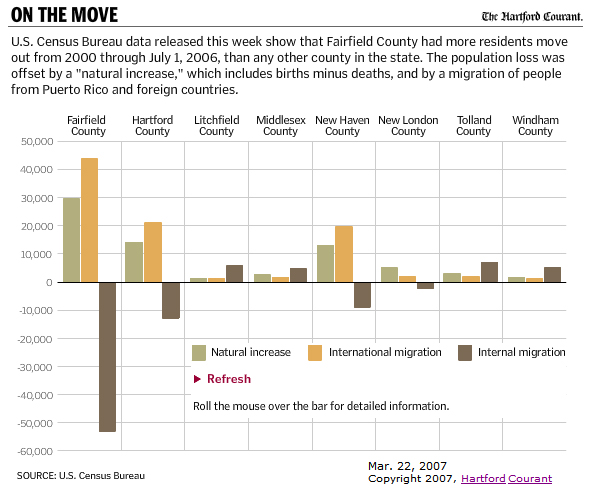 |
 |
|||
|
||||
| Web Sites, Documents and Articles >> Hartford Courant News Articles > | ||
|
Census: Shifting Growth Patterns Immigration A Powerful Force March 22, 2007 If the immigration controversy can be said to have an epicenter in Connecticut it would be Fairfield County, where anti-immigrant forces have made issues of Ecuadorean basketball games in Danbury, worker pickup zones in Stamford and Latino employment at fast-food restaurants all over.
But new census data suggest that without immigration, the county would have had sharp population declines in this decade as tens of thousands of residents left for other parts of the country. New estimates of population released by the U.S. Census Bureau this week say that Fairfield County lost almost 53,000 more residents to other areas in Connecticut and other states than moved in from those places between the 2000 Census and July 1, 2006. That loss was more than double the combined net out-migration from the state's next two largest counties, Hartford and New Haven. But an influx of nearly 44,000 newcomers from Puerto Rico and foreign countries helped the county eke out a scant 2 percent growth rate in that time, lagging behind every other county except New London. "One of the other things that's not well-known or appreciated in Connecticut is the absolutely essential need for immigration into the state," said Peter Gioia, vice president and economist at the Connecticut Business and Industry Association. "Certainly you prefer more highly skilled and trained people. But there's also a tremendous need for support staff of all types. You can't drive down any street in Fairfield County and not see `Help Wanted' signs all over the place." One thing the census estimates don't make clear is where the new residents are coming from. The bureau lumps arrivals from Puerto Rico and foreign countries together under the heading "international migration," although Puerto Ricans are U.S. citizens from birth. Other demographic data, however, show that the Hispanic population of Fairfield County, as in the rest of the state, has grown far more quickly than the population as a whole. By July 1, 2005, the county had become the most heavily Hispanic in the state, with about 128,500 residents, more than 14 percent, identified as Latino by the census. According to the Census Bureau's 2005 American Community Survey, a large-scale sampling of households distinct from the census population estimates, that Latino population also was more diverse than elsewhere in Connecticut. Substantial majorities of Latinos in Hartford and New Haven counties - about 70 percent and 61 percent, respectively - are of Puerto Rican heritage, according to the survey. In Fairfield County, the proportion of Puerto Ricans in the Hispanic population is about 37 percent, with large communities of Ecuadorian, Colombian, Guatemalan and other South and Central American immigrants. They help give the county the highest proportion of foreign-born residents in the state, about 18.5 percent, according to the survey. The Rev. Richard Ryscavage, a sociology professor and head of the Center for Faith and Public Life at Fairfield University, said that he sees several reasons for the relative diversity of the Latino population. "Part of the difference has to do with the socioeconomic situation in Fairfield County, which attracts a stronger diversity because there's more diversity of employment opportunity," he said. "Proximity to New York City is another factor," he added, with some immigrants who first came to the city "resettling" in Fairfield County and staying there to keep in touch with relatives. The census also doesn't try to break out illegal immigrants, the particular targets of anti-immigrant activists. It's difficult to find reliable figures on the subject; the Pew Hispanic Center last year estimated that 70,000 to 100,000 unauthorized immigrants live in the state. The broad category of international migration also buoyed the population of the state as a whole between 2000 and 2006, especially Hartford and New Haven counties. Both counties gained several thousand more residents from international migration than they lost through what the census calls "internal migration" to the rest of the nation. But nowhere else in the state has the population been so shaped by movements in and out of the county. The 53,000-person loss to internal migration tallied by the Census Bureau represents almost 6 percent of Fairfield County's population in 2000; the 44,000 gain from international migration is nearly 5 percent. Edward J. Deak, economics professor at Fairfield University, said that both numbers seemed high, especially the internal migration number. "You wouldn't have seen the vigor in the housing market for the period '02 to '05 if there had been that kind of loss," Deak said. The immigrants to the county would have to have high incomes to sustain the housing market, he said, "and I just don't see that many people working as bioresearch scientists, engineers, financial service people, hedge fund employees, banking employees or something of that type." Gioia, however, said that the figures are not surprising. Internal migration - people leaving for destinations in the United States - in part reflects the mobility of employees in large corporations and in part the aging of an affluent population that chooses to retire elsewhere. The international migration, he said, is a product of the particular geographic and economic situation of Fairfield County. "It's the most diverse county ethnically, racially and otherwise in the state," he said. "The proximity to New York City makes it a heck of a lot easier for international migration, and there's an awful lot of opportunity within the county."
|
||
| Last update:
September 25, 2012 |
|
||
|

